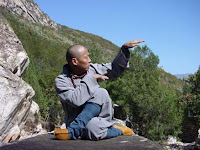Tiger Style
The Tiger style is characterised by its extensive footwork,acrobatic kicks, low, wide stances, and unique fist position (where the thumb is curled in the same manner as the other fingers, rather than wrapped around them). According to Master Shi Yan Xiu, this style is the most externally focused style in the Shaolin arsenal. The longer the student practices, however, the more he or she will come to rely solely on internal power.
Crane Style

The focus of the White Crane style is to make less use of physical strength, stressing evasion and strategic attacks to vulnerable areas instead. This style is especially well-suited for women's self defence as it is not purely strength-based.
Snake Style


The Snake style is on the fluidity of the movements. Straight punches, butterfly palms, the hook, upper cut, and back fist are the primary cornerstones of this technique. Thrusting fingers resembling snake attacks is one of the distinguishing features of this form, hence the name "Snake Style."
There are multiple kick techniques including below-the-knee kicks. There are six fist sets, two stick sets, single sword, short double swords, and other traditional weapons.
Leopard Style

The Leopard style is on speed and angular attacks. The leopard does not rely solely on strength like the Tiger, but instead relies on speed and outsmarting the opponent., The Leopard practitioner will focus on his or her elbows, knees, low kicks, and Leopard punches in order to build speed.
Dragon Style

The Dragon style is based on a variety of fighting techniques that can be employed for a wide range of needs. The style uses techniques that can cripple or kill an opponent if the need arises or it can be used simply to control a minor street fighting situation.
Lung Ying (Dragon Shadow) focuses mainly on powerful, short range attacks. Its usage of grip and seize techniques as well as its extensive use of the forearms offensively and defensively is one of its unique features. The style was created as an aggressive combat art and operates under the assumption that you are trying either to disable your opponent to the point that they are no longer a threat in battle, or kill them, though these are by no means the only options a Lung Ying practitioner has at his disposal.
Lung Ying employs a large number of techniques to damage the opponent's joints either through joint manipulation or direct striking, or nullify the opponent's defences either through breaking their stance or compromising their guard. Compared to other styles, there are few kicks and jumps. Emphasis is rather laid upon fist, palm and claw techniques. Power is generated from the waist.
Lung Ying training also involves an extensive amount of iron body training. Hardening the forearms especially is considered essential for this style as it makes such extensive use of them. Master Shi Yan Kiu uses a range of traditional training methods to toughen the body. Three, five and seven star conditioning drills, pea buckets, weighted ropes, sand bags, and striking poles are all exercises common to this particular style.
Monkey Style

Monkey style is one of the more acrobatic styles. Movements often include falling, lunging, grabbing, jumping, and tumbling. The staff plays a prominent role in weapons training, with practitioners using it to attack, defend themselves or climb it like a pole in order to gain a height advantage during combat.
The flamboyant movements and sometimes comic actions of the monkey style have made it a popular style.

The Praying Mantis style focuses on "sticky hands" - the use of the forearms with the elbows tucked into the chest, the claw-like fingers and the quick explosive actions visually resemble the movements of a praying mantis preparing to strike its prey.

0 comments:
Post a Comment